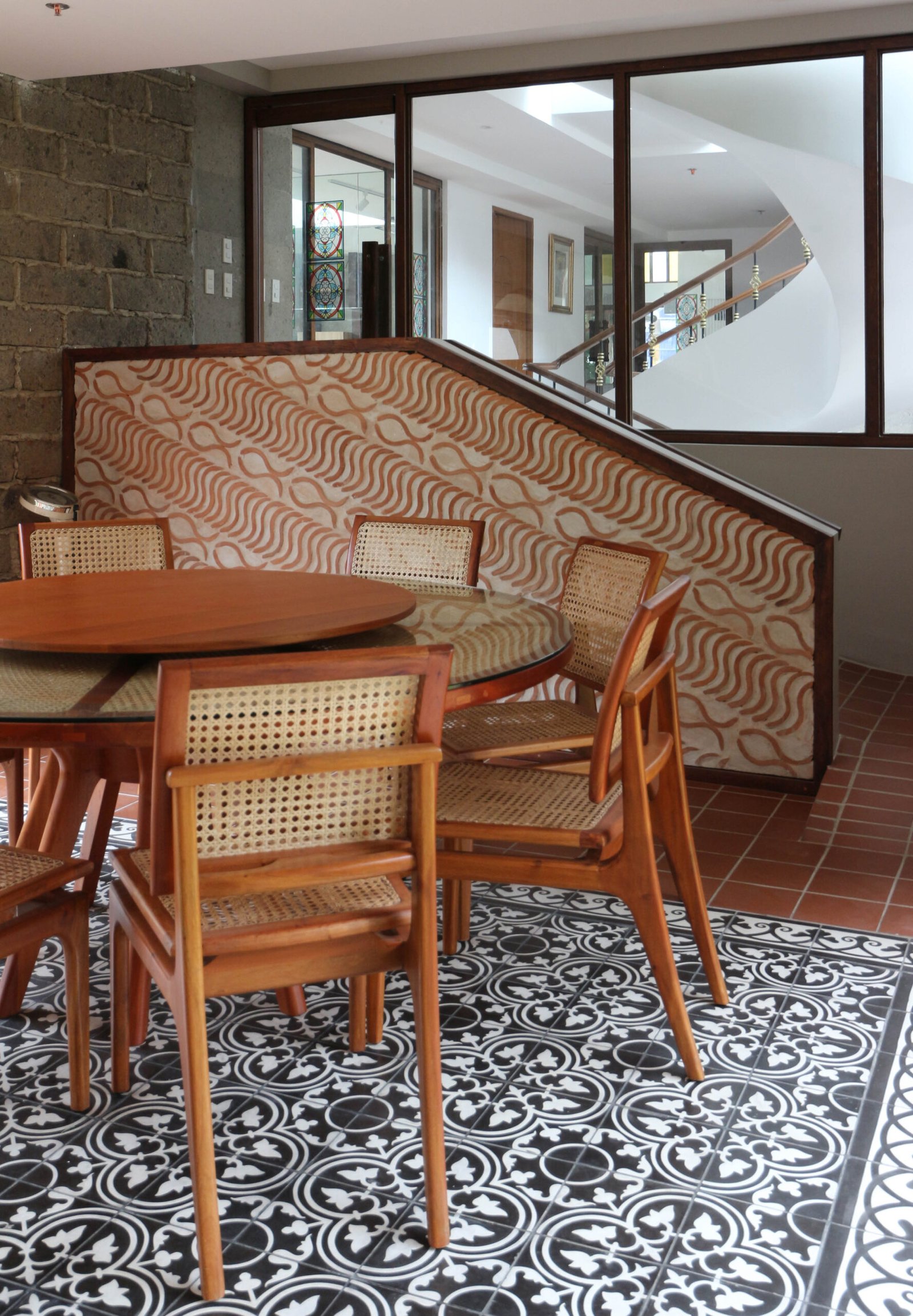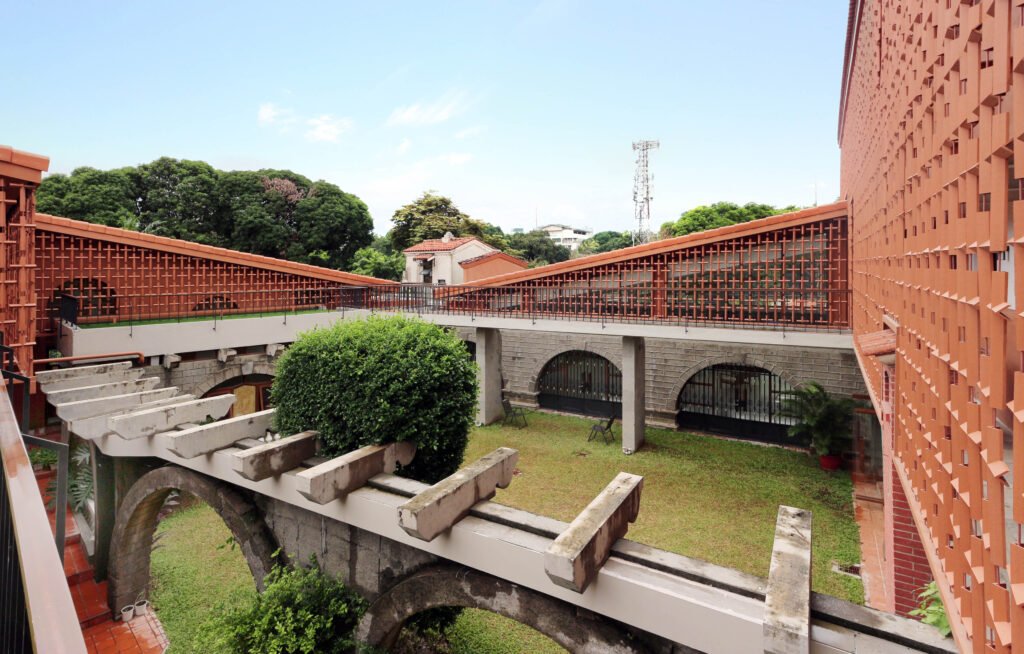Interview and Images Patrick Kasingsing
Words Miguel Llona


Our coverage is proudly supported by LIXIL Philippines


“The house had to die.”
So went this single line that cuts like a blade in Studio Fuerzo’s boards for the New Provincialate House, their shortlisted entry for the 2022 World Architecture Festival in the Religious Buildings category. Though foreboding, the statement actually points to rebirth and renewal, almost too fitting for a 1950s Mission Revival-style house that served as the headquarters for the Fathers and Brothers of the Congregation of the Blessed Sacrament.
The 70-year-old structure had succumbed to time in both its appearance and functionality, standing in a state of disrepair by the time Studio Fuerzo was hired by the congregation to usher it to a new life. They were tasked to “renovate it in a way that retains and references the character of the original mid-century house,” the reason being the congregation was getting bigger and needed more space for a chapel, function hall, bedrooms, and auxiliary spaces. This is why the existing structure, with its outdated programming and declining state, had to die so it could rise again.


The teardown wasn’t total, however, as Studio Fuerzo retained the original masonry and reinforced concrete walls of the house, with only the termite-infested wood elements such as columns, beams, and roofs removed. Though used by the congregation for decades, it was not originally designed for religious purposes, much less a place that can accommodate a large number of people. The original house was designed and owned in the 1950s by Arturo Mañalac, an architect who built structures for religious congregations. In the year 1987, Architect Mañalac sold his house to the Congregation of the Blessed Sacrament, and it has since become the main home for the members of the congregation which they considered the “Provincialate House” (headquarters).
A defining feature of the Provincialate House is its central courtyard, around which the different structures of the compound congregated around, and which Studio Fuerzo was determined to keep due to the character it brought to the place. “Their requirements for the new design demanded a bigger floor area, but since we didn’t want to touch the courtyard, we had to expand backward,” says Daryl Refuerzo, principal architect of Studio Fuerzo. Opening up a dialogue between the courtyard and the new public spaces that the congregation required was a priority, so the design team came up with the elegant solution of having these public spaces be on the same level as the courtyard, at the same time building structures over and under them. In connecting all these spaces together and reorienting the circulation of the compound, the New Provincialate House “[inspires] new experiences in familiar places: doors opening to gardens; hallways leading to more roof decks; and a bridge [beckoning towards] an underutilized balcony that has the best view of the compound.”




The most noticeable change to the house is the addition of terracotta-colored wood screens with cruciform patterns, which cover the top halves of the compound’s structures. Though Refuerzo admits they do little in terms of screening against sunlight, these wooden screens serve the purpose of adding a “visual duality” to each structure, giving them the material appearance of a bahay na bato in that the bottom level is made of adobe stone, while the upper levels are cloaked in wood. The flourish is a visual homage to the house’s original architecture, which Refuerzo describes as “a crossover between a Spanish stone house and American wooden bungalow.” The screens also function as a harmonizing element, uniformly ‘draped’ over the facades of the structures within the compound like a veil.
The empathy towards the past and respect for its spiritual nature is likely what earned the New Provincialate House its shortlist placement at the WAF. Exhibiting a conscious effort to preserve as much of the old structure is admirable for a firm as young as Studio Fuerzo, given how challenging and labor-intensive adaptive reuse can be. “It’s a gesture of acknowledgment that [the house’s] past self deserves,” says Refuerzo. Resurrecting a dying structure and giving it new life aside, having that mentality alone should be worthy enough of the WAF’s attention.


The interview
Why did you select this project for the competition? What do you think makes it winnable?
Daryl Refuerzo, Studio Fuerzo: It’s one of those projects where everything is aligned—a context that’s historic, a building that’s unique, a client willing to take risks, and an unconventional solution. It all makes for a solid narrative worth sharing.
What do you hope to get out of the WAF experience (aside from winning of course)?
As a young studio, we want to tell the world our stories and WAF will definitely be a great platform for us. We hope to learn also from highly creative individuals by absorbing and indulging in their energies and ideas. And to fanboy, of course.
What improvements/enhancements will you be making to your presentation as opposed to the project package that you submitted?
We’ll include more photos, especially the interiors and details. Two A2 boards were just not enough to capture the narrative of the building.


An old onyx panel provides a radiant backdrop to the confession room 

Aged terracotta roof tiles are reborn as accent wall cladding forming religious motifs


This is the Philippines’ largest showing at the WAF in its eighth year of participation; would you recommend more studios and firms join the competition? Why so?
Back in 2019, we were already thinking of joining WAF halfway through the design process of this project. Aside from tending to the client’s needs, the studio was forced to reevaluate our philosophies and approaches to design with the competition in mind. By getting a deeper sense of what’s being done out there by reviewing past entries, we were inspired to step up our game even more. So yes, we encourage others to join next time because the whole experience can be transformative to their practice.
When should you join the WAF? As a fledgling studio? As an established firm?
As long as you have a solid story to tell, just join.


How is the wood composite screen equipped to handle the country’s extreme weather conditions?
We designed the screen to be light and resilient enough to withstand extreme weather. Each column of crosses is isolated so it can move independently. It’s been almost a year since we installed the first sets of crosses and so far, they are holding up pretty well.
What else do the beautiful cross-patterned screens do for the project?
As much as we’d like to say that it plays a major role in blocking sunlight, it really just “helps” filter around 30% of the screen’s surface area.
We really wanted the house to reference where the old Spanish friars lived. The idea for the screens, or “terracotta veils” as we internally call these, came from the visual duality of the bahay na bato—bato for the ground level, wood for the second. This duality is replicated in the house—adobe for the ground level, terracotta for the second. The screens went through many design iterations, from stone (alabaster, translucent marble, and translucent slate veneers), local terracotta tiles (very brittle and dangerous), rusting iron (very wabi-sabi and trendy but the fathers were not sold), to acetylated wood (they were really anxious about using wood again because of cost and maintenance). Eventually, we settled on wood plastic composite sections, which are light enough, relatively cheap, and easily replaceable, mounted on steel angles welded to the rods. We matched the color with the terracotta roofing for a stronger visual identity.
So, most of what the “beautiful” screens do is to make the building beautiful. Reflecting upon the styling of architecture back then, it was really all about tropicality and horror vacui. Our heritage houses, despite being spartanly simple, are laden with rich, decorative elements referencing local flora, for example. We felt that ornamentation has been lost in contemporary architecture and it just felt right to explore it in this project.
Did the congregation have initial misgivings with regards to the modernity your design brings to the compound? Were they openly receptive to the major changes you proposed?
Surprisingly, they liked it from the initial iterations/proposals. Apart from maintenance, the only major resistance to our plans was the cost.




Aside from the congregation’s brief to modernize the space, did they have models or expectations that they communicated to your team? Did they stipulate the need to utilize as much of the old building materials within the refreshed design?
Yes. They were very adamant about utilizing anything from the old structure as much as we can. We also accommodated their requests to imbue certain symbols/motifs into some of the architectural elements. Aside from these, they gave us freedom on how to approach the new spaces.
Were there major changes to how the structures of the compound are laid out or its different spaces are programmed within the site?
None. We are just currently enhancing the path walks connecting each building.
What would you say is the most challenging part of this project? What made it so?
The most challenging part is the chapel. It’s the core of the house so special attention and a lot of time have been given to details like lines of sight, positioning of the Catholic symbols rooted in liturgical tradition, lighting, etc. Marble selection and installation were also a challenge since each area in the sanctuary has a specific grain direction. It was easier to execute and install the terracotta veils, to be honest.


What were the notable attributes of the old building or compound that for you was vital to retain?
The Mission-Revival style “towers” lend a very distinctive character to the old house. The west tower had no purpose and the east tower was a bedroom. Externally, we tried to respectfully design around these towers, consciously shaping and tapering the upper terracotta levels to highlight these elements. Internally, we converted them into powder rooms, rendered and dignified by the use of terrazzo and Machuca tiles.
What was the most expensive design element/execution pursued in this renovation?
It’s probably not the most expensive per se, but the donated blue Bahia stone cladding, used as a backdrop for a statue, looks precious and ethereal.
What has your project experience revealed to you about your craft?
That God is in the details.


What’s the most heartwarming response you’ve received about the project?
“Ang ganda. Parang luma na bago.” [It’s beautiful. Like old but new.] We’re glad that people get our intent and are responding positively to the mix of nostalgia and newness.
Did the remaining masonry and concrete structures pose any challenges to the renovation? We noticed that there is a conscious effort to set apart the old and new in the design; why did you think this was best for the project?
Aside from waterproofing the connections, there weren’t any other challenges. These structures actually form the backbone of the design—they support, ground, and restrict the architecture. We had to work around these “ruins” to create those remarkable moments of serendipity that would have been lost had we chosen to demolish everything and start with a clean slate.
There’s a conscious effort to highlight the old design. It’s a gesture of acknowledgment that its past self deserves. It’s also a design commentary on adaptive reuse, offering an alternative response to the meaning of change.
What insights or observations did the whole exercise reveal to you about how man approaches spirituality? How does your design enhance the introspective and meditative aspect of faith and spirituality?
Spirituality is universal. Even though our client is a religious order, we approached the project brief from a secular perspective. We shied away from the familiar design language and motifs that contemporary religious buildings usually resort to. We designed the architecture to elicit feelings and connections to the divine, whether one is religious or not. •






One Response